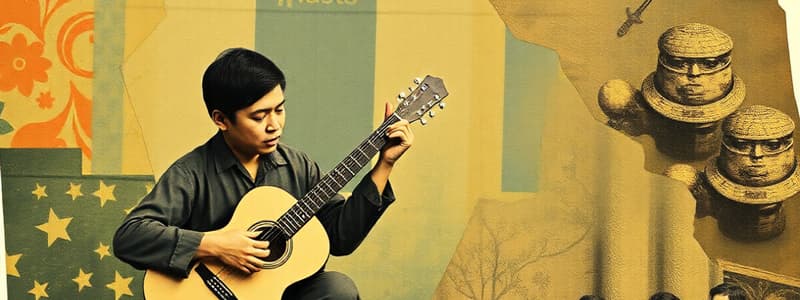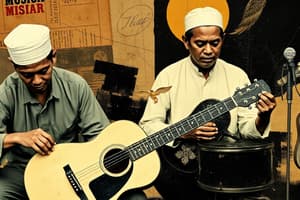Podcast
Questions and Answers
In Mindanao, what are the two primary musical and cultural traditions that influence the type of music produced?
In Mindanao, what are the two primary musical and cultural traditions that influence the type of music produced?
- Islamic and Non-Islamic cultures (correct)
- Coastal and Highland influences
- Lumad and Igorot traditions
- Christian and Muslim cultures
How is vocal music primarily used in Mindanao's musical traditions?
How is vocal music primarily used in Mindanao's musical traditions?
- For competitive singing contests between villages
- To accompany agricultural activities
- As background music for royal ceremonies
- To express thoughts, emotions, and spiritual beliefs (correct)
During which occasions are religious chants (lughu) typically performed in Mindanao?
During which occasions are religious chants (lughu) typically performed in Mindanao?
- During Friday noon services, Molud or Mawlid celebrations, Puwasa or Ramadan, and commemorations of the dead (correct)
- Throughout daily activities to maintain spiritual harmony
- Exclusively during harvest festivals
- Only during weddings and funerals
Which of the following best describes the vocal music characteristics unique to Mindanao?
Which of the following best describes the vocal music characteristics unique to Mindanao?
What is the term used for songs that serenade loved ones in the Yakan musical tradition?
What is the term used for songs that serenade loved ones in the Yakan musical tradition?
What is the function of Kissa songs in the Tausug culture of Mindanao?
What is the function of Kissa songs in the Tausug culture of Mindanao?
What is the general term used by Maguindanao people to describe the entire instrumental ensemble?
What is the general term used by Maguindanao people to describe the entire instrumental ensemble?
What musical element primarily defines the Tagongko, differentiating it from other forms of Kulintang music?
What musical element primarily defines the Tagongko, differentiating it from other forms of Kulintang music?
How does the Kapanirong tradition in Mindanao relate to courtship rituals?
How does the Kapanirong tradition in Mindanao relate to courtship rituals?
What does the term 'Lumad' generally refer to in the context of Mindanao's cultural groups?
What does the term 'Lumad' generally refer to in the context of Mindanao's cultural groups?
Which aspects of life are commonly reflected in the songs of Non-Islamic communities in Mindanao?
Which aspects of life are commonly reflected in the songs of Non-Islamic communities in Mindanao?
What are the 'Sinda-ay' and 'Balatuking' in the context of Manobo musical traditions?
What are the 'Sinda-ay' and 'Balatuking' in the context of Manobo musical traditions?
What distinguishes the 'Kudlong' from other indigenous instruments used by Non-Islamic communities in Mindanao?
What distinguishes the 'Kudlong' from other indigenous instruments used by Non-Islamic communities in Mindanao?
What is the unique characteristic of the 'Agong a tamlang' among the instrumental traditions of Mindanao?
What is the unique characteristic of the 'Agong a tamlang' among the instrumental traditions of Mindanao?
How do the religious practices and traditional rituals influence the indigenous music of Mindanao?
How do the religious practices and traditional rituals influence the indigenous music of Mindanao?
Which of the following describes the role of religion in both Islamic and non-Islamic music in Mindanao?
Which of the following describes the role of religion in both Islamic and non-Islamic music in Mindanao?
Which instruments typically accompany vocal music in Mindanao?
Which instruments typically accompany vocal music in Mindanao?
What is the Kadikir, a type of Maranao song, primarily about?
What is the Kadikir, a type of Maranao song, primarily about?
Among the Maranao songs, which type is a combination of the styles found in kandarangen and kadikir?
Among the Maranao songs, which type is a combination of the styles found in kandarangen and kadikir?
What is the purpose of performing 'kalilang sa tong' ceremonies that involve the Tagongko ensemble?
What is the purpose of performing 'kalilang sa tong' ceremonies that involve the Tagongko ensemble?
What is the term used for lullabies among the Tausug people to put babies to sleep?
What is the term used for lullabies among the Tausug people to put babies to sleep?
If one were to hear a Maranao song performed gently with private sentimentality, how would it be classified?
If one were to hear a Maranao song performed gently with private sentimentality, how would it be classified?
What is the primary purpose of 'Lugu' in the Yakan tradition?
What is the primary purpose of 'Lugu' in the Yakan tradition?
How is the Kulintang ensemble traditionally played?
How is the Kulintang ensemble traditionally played?
What is the term for a melodious lament sung over the dead in Maranao culture?
What is the term for a melodious lament sung over the dead in Maranao culture?
What non-Islamic community wedding chant is called 'Sinda-ay'?
What non-Islamic community wedding chant is called 'Sinda-ay'?
What is palakpak?
What is palakpak?
What material are Tambuli made from?
What material are Tambuli made from?
What is the T'boli term for the Suling?
What is the T'boli term for the Suling?
Flashcards
Mindanao Music
Mindanao Music
Mindanao's music is based on Islamic and Non-Islamic cultural traditions.
Music functions in Mindanao
Music functions in Mindanao
Vocal music expresses thoughts/emotions; instrumental accompanies dances/rituals.
How chants and lullabies are described?
How chants and lullabies are described?
Majestic and serene
Vocal music reflects
Vocal music reflects
Signup and view all the flashcards
When are Religious chants (lughu) sung?
When are Religious chants (lughu) sung?
Signup and view all the flashcards
Secular songs
Secular songs
Signup and view all the flashcards
Islamic cultural communities
Islamic cultural communities
Signup and view all the flashcards
Kadikir
Kadikir
Signup and view all the flashcards
Kandarangen
Kandarangen
Signup and view all the flashcards
Type of song: Kissa
Type of song: Kissa
Signup and view all the flashcards
Parang Sibil meaning
Parang Sibil meaning
Signup and view all the flashcards
Kalangan songs
Kalangan songs
Signup and view all the flashcards
Instrumental music
Instrumental music
Signup and view all the flashcards
Kulintang
Kulintang
Signup and view all the flashcards
Tagongko
Tagongko
Signup and view all the flashcards
Kapanirong origin
Kapanirong origin
Signup and view all the flashcards
Lumad definition
Lumad definition
Signup and view all the flashcards
Sinda-ay
Sinda-ay
Signup and view all the flashcards
Balatuking purpose
Balatuking purpose
Signup and view all the flashcards
Diwata's Use
Diwata's Use
Signup and view all the flashcards
Kudlong instrument
Kudlong instrument
Signup and view all the flashcards
feature of Takumbo
feature of Takumbo
Signup and view all the flashcards
Palakpak is made from
Palakpak is made from
Signup and view all the flashcards
What is a Suling?
What is a Suling?
Signup and view all the flashcards
Instrument called Tambuli
Instrument called Tambuli
Signup and view all the flashcards
Tugo is...
Tugo is...
Signup and view all the flashcards
Define Mindanao music
Define Mindanao music
Signup and view all the flashcards
Study Notes
Mindanao Music Overview
- Mindanao is home to diverse cultural communities, each possessing unique traditions.
- Music traditions are based on Islamic and Non-Islamic cultures.
- Chants and lullabies are considered majestic and serene.
- Instrumental music is significant, sharing equal importance with vocal music.
Vocal Music Types
- Vocal music expresses emotions and thoughts while instrumental music accompanies rituals and dances.
- Vocal music reflects the natural and spiritual life of Muslims, Christians, and Lumads.
- This music is considered one of the richest artistic and technical expressions among indigenous groups.
- Religious chants (lughu) are sung during Friday noon services, Molud/Mawlid, Puwasa/Ramadan and commemorations of the dead..
- Secular songs include lullabies and love or legend chants.
- The vocal music includes long melodic chanted lines with unique rhythms, like the "Tidtu" and "Binalig".
- The vocal music consist of four notes, and indigenous instruments such as hegalung, suling and gongs usually accompany the music.
Islamic Vocal Music
- The Islamic cultural community consists of Maguindanaos, Maranaos, Yakans, Samals, and Tausugs, and uses lots of vocal in practices.
- Some vocal styles vary in purpose and from village to village.
- Vocals may be performed solo, in a call-response manner, and often include embellishments, tremolo, and a nasal singing style.
Maranao Songs
- Kadikir is a song with a slow, free rhythm about verses from the Qur'an and Maranao themes, with morals, life, death and Islam.
- Kandarangen is accompanied by gongs or instruments like them.
- Kandomana combines styles of kandarangen and kadikir.
- Kapranon is a song of private sentimentality, sung softly.
- Bayok is a Maranao lullaby.
- Kandidiagao is a lament rendition that is melodious.
- Dikker are sacred songs, quoting the Qur'an.
Tausug & Yakan Songs
- Kissa is a datu and princess love song.
- Parang Sibil is a heroic song.
- Lugu accompanies readings from the Qur'an and Islamic books.
- Kalangan serenades loved ones.
- Yaya are lullabies.
Instrumental Music
- Played solo or as an ensemble to accompany dances and rituals.
- Kulintang music, the Maguindanao term for a complete ensemble is basalen or palabunibunyan.
Islamic Instrumental Ensemble
- Kulintang consists of horizontally-laid gongs for melody, suspended gongs, and drums; played using two wooden beaters on the gong bosses.
- Tagongko is parade music for male musicians in festive attire, played during ceremonies such as welcoming dignitaries and weddings.
- Tagongko is performed to attract spirits for good harvests or a bountiful catch in "kalilang sa tong".
- Kapanirong ("beside a house") is like the Tagalog harana, where young men play music by a maiden's window.
Non-Islamic Music
- Lumad refers to native Christians and non-Muslim indigenous groups in Mindanao, including Dibabawon, Tagakaola, Bagobo, Ubo, Teduray, Subanon, B’laan, Mandaya, Higaonon, Banwaon, Talaandig, Mansaka, Manguanan, T’boli, and Manobo.
- Common song themes in non-Islamic communities include nature, work, rituals, and other ceremonies.
- The Manobos use the Sinda-ay wedding chant and the Balatuking harvest song, while Subanons use the Diwata for curing ceremonies.
Non-Islamic Instrumental Music
- Kudlong is a stringed instrument played with a plectrum.
- Takumbo only produces low tones.
- Palakpak, made of bamboo, consists of two parts struck together.
- Agong a tamlang (bamboo gong) has a closed node at one end, open at the other, and tapers at the tip.
- Suling, called siloli by the T'bolis, has a palm leaf coiled at the closed end.
- Tambuli is trumpet made of carabao horns.
- Amel is made of hollow log or wood and covered in animal skin.
- Tugo is a is wide, short drum used by Tirurays.
General Information
- Religious practices and rituals influence indigenous music, combining West Asian mysticism and Southeast Asian animism.
- Religion is essential to both Islamic and non-Islamic music in Mindanao.
Studying That Suits You
Use AI to generate personalized quizzes and flashcards to suit your learning preferences.




